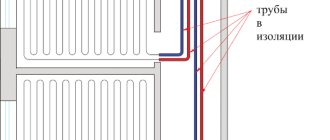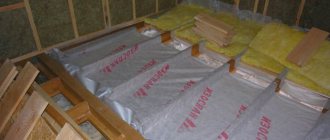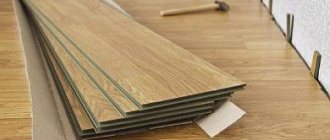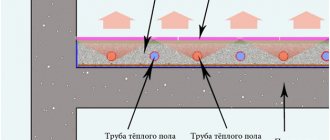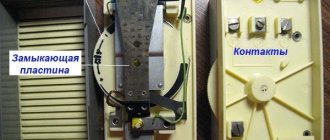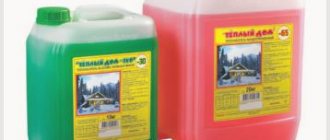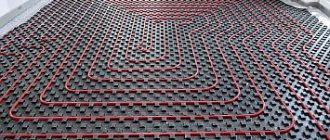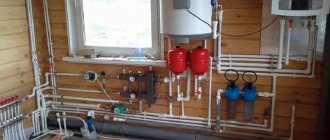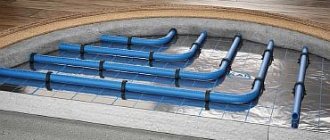When installing a floor heating system, a screed is required. This concrete base is necessary not only to create a completely flat surface, but also to protect the water and electric heating elements, which are mounted directly into the cement slab, from mechanical damage and stress. However, due to the powerful equipment, you need to be sure that the coating can withstand the effects of high temperatures, so a plasticizer is added to the concrete solution to screed the heated floor.
Plasticizing additives have a number of advantages, due to which the characteristics of cement-sand mortar are improved.
Is a plasticizer needed and its purpose?
A plasticizer is a component designed to make concrete for heated floors elastic and durable, while the surface is more even and smooth.
This substance improves the solubility of cement clinker, which helps attract particles to each other, pushing air and excess water towards each other, thereby making the mixture more elastic. It turns out to be more dense, which means it dries better, there is practically no shrinkage, and moisture does not penetrate into it.
In addition, the additive protects the concrete coating from deformation under the influence of heat, regardless of the type of heated floor: water, electric or infrared.
For your information! The plasticizer contains only components that are safe for human health, they are non-toxic, and do not have an unpleasant odor.
The main disadvantage of adding an additive to the solution for pouring heated floors is the increase in the cost of the structure, and a more complex installation process, since the mass needs to be in constant vibration.
Results
Screed for heated floors (water or electric) can be wet or semi-dry. Wet is a traditional composition of cement, sand and water. Semi-dry screed is when plasticizers and reinforcing additives are added to cement and sand. As a result, the solution for a warm floor acquires greater strength, becomes more plastic and fills the slightest voids, absorbs less moisture. When drying, the formation of cracks also decreases, the screed becomes more uniform and has greater thermal conductivity. Conclusion: the use of plasticizers when pouring heated floors is highly desirable.
Properties and types
A plasticizer for cement mortar, intended for the construction of heated floors, has properties that have a positive effect on their quality.
The main properties of additives used in the manufacture of cement mortar for heated floors:
- repel liquid;
- withstands sub-zero temperatures down to -25°C;
- have a neutralizing effect on potassium nitrate in the amount of 5% of the total mass;
- protect the concrete base from the negative effects of chemicals;
- have inhibitory qualities;
- impart strength by reducing the surface tension of water;
- reduce the ability to crack.
It is important to correctly determine which type of plasticizer is suitable for the floor, because this affects both the service life of the heating system and your electrical energy costs.
When using a concrete mixture without a plasticizer, uneven heating of the surface and a decrease in thermal conductivity are possible, since there are air voids in the screed. It is better to add a plasticizer in the form of an emulsion, then the mixture will be more homogeneous.
By type of additive there are:
- liquid - they are easy to work with and there is no need for preparation;
- dry - stored for a long time, but require kneading;
- reinforcing - equipped with additional chemical elements that give strength to the screed;
- anti-frost - used for outdoor work.
Short description
If, when laying the mixture, air pockets are formed, this entails a decrease in the functionality of the floor heating system as a whole. Floor plasticizer can be bought at any hardware store, and this is the right choice, as it will make the concrete mixture better and more homogeneous, and this will have a beneficial effect on the pour.
The mixture becomes plastic, and due to its universal composition it receives additional pleasant properties:
- Increased performance characteristics.
- Waterproofing.
- High adhesion rates (this is the ability to bond with different materials).
Manufacturers and cost
When choosing a plasticizer for a solution, you should take into account its compatibility with heated floors. The cost of the screed additive also plays an important role.
Today there are many companies in the world that specialize in its production. Let's look at the main manufacturers.
Isomat Plastiproof
Isomat Plastiproof (Greece) is a waterproofing material with plasticizer properties. Improves the physical characteristics of concrete and reduces the level of water absorption.
Increases elasticity and prevents the formation of air voids in the solution. The composition does not contain chlorides or other substances that cause corrosion.
The use of Isomat Plastiproof makes it possible to create high-strength concrete that can be pumped. Compatible with any type of concrete. Available in cans from 5 to 20 kg, and in barrels of 240 kg. On average, the price of 5 kg costs 1200 rubles.
Sanpol
Sanpol is a country of origin: Ukraine. The substance is a mixture of liquid consistency, of excellent quality. Designed for screeding underfloor heating, as it can increase the strength and thermal conductivity of the structure. The use of this type of additive reduces water consumption by up to 15%.
The process of pouring screed is long and quite complex, which requires some experience. But its advantage is that Sanpol slows down the rate of setting of the mixture, this makes it possible to correct mistakes, especially suitable for those who are working with concrete for the first time.
For your information! The plasticizer for underfloor heating in concrete is taken at the following rate: 0.1 liter per 200 kg of cement. On average, the price in the aisles is 140 rubles per liter.
DEG-1
DEG-1 is an epoxy resin, belongs to the group of additives, used as a casting plasticizer. Its special qualities are that the plasticity of the mixture increases, while the strength decreases. The main disadvantage is that it cannot be used for the manufacture of transparent products.
Produced in Russia, the price for 1 kg of product is 9860 rubles.
ArmMix
The composition is water-based, recommended for installing floors and obtaining a dense and waterproof concrete product. Manufacturer Russia - . According to the consumption rate per 1 liter. modifier requires 100 kg of cement powder.
It is prepared in two ways: by mixing the substance with water in a special container, or by adding it directly to the cement-sand mortar. The cost is 100 rubles per liter.
Pros of this brand:
- reduces cement consumption;
- promotes the formation of a concrete mixture with high density;
- can be used at high sub-zero temperatures;
- reduces the process of screed deformation to a minimum;
- increases the plasticity of the concrete mass.
Warm floor HLV-75
The main purpose of this type of plasticizer is to facilitate high-quality installation of any type of underfloor heating, regardless of whether it is a water or electric system.
It is added directly to the mixture while stirring it or to the water before preparing the solution. The modifier must be stirred thoroughly so that it is evenly dispersed in the concrete.
The main advantage of this type:
- increases the mobility and thermal conductivity of concrete screed;
- protects against cracking;
- reduces cement consumption by 20%;
- protects reinforcement from corrosion;
- accelerates hardening by 4 times.
Designed for installation of heated floors, rough or finishing screed is possible. Produced in Ukraine. The price is 620 rubles for 2 kg of dry product.
Rehau
This brand (country Germany) is recommended for pouring thin concrete screed when installing heating systems. This is a superplasticizer for underfloor heating, it is considered the best model - premium class.
Available in both dry and liquid form. Sold in 10 kg containers, one canister costs 3,000 rubles. The products are of high quality, environmentally friendly and harmless to health.
When a plasticizer is added to the cement mortar, the strength of the floor and thermal conductivity increases, and its physical properties improve. In addition, the likelihood of concrete cracking is significantly reduced, since the mixture contains an optimal ratio of water and cement.
Plasticizer S-3
Product S-3 (Russia) is a viscous cream-colored liquid. Packaged in metal or plastic canisters of different volumes, from 0.5 to 10 liters. It is used in the manufacture of mortar, together with solid fillers. Cost 10 l. — 1000 rub.
Like all plasticizers, this model makes the solution for underfloor heating stronger (by 35%), makes it possible to save on cement, significantly reduces the volume of water in the solution, improves water resistance (by 18%), and promotes the adhesion process.
Before adding, you need to mix it thoroughly; 100 kg of cement will require 1 liter of additive. If a dry additive is used for warm floors, then you need to dilute it with warm water and leave for several hours until the mass becomes homogeneous. To one part of powder you need to add 2 parts of water.
Semi-dry screed
To reduce the number of shortcomings of a concrete screed, it is necessary to introduce plasticizers and additives into the screed for heated floors. Thanks to this, the properties of the solution change and drying time is reduced. In addition, additives allow you to use less water, which is why the screed is called semi-dry.
Using such a screed has several advantages:
- Short drying time due to small amount of liquid.
- Getting a smoother surface.
- Increasing the water resistance of concrete, which is especially important for floors in bathhouses, bathrooms and kitchens.
- Maintaining plasticity for a long time, which allows you to mix a larger amount of solution.
- The plastic mixture for filling the heated floor is laid more densely, filling the voids as much as possible. As a result, the screed is characterized by uniformity and higher heat transfer.
- During the maturation of the screed, cracks do not appear, since shrinkage is practically absent.
- The surface can be used within 12 hours.
- In most cases, the topcoat can be installed after 28 days, and when certain additives are added to the solution, after 7 days.
This method also has disadvantages, including the following:
- Higher cost of some mixtures for heated floors.
- Significant coefficient of vapor permeability.
- Long initial setting of the solution. In this case, the problem can be solved using a special hardening accelerator.
For semi-dry screed, you can use a ready-made mixture for heated floors, to which it is enough to add a certain amount of liquid in accordance with the instructions on the package. In addition, you can purchase plasticizers separately and add them to the solution at your discretion. All dry mixtures for heated floor screed contain certain components, so you should follow the manufacturer's recommendations for preparing a solution for semi-dry screed.
One of the modern methods of reinforcing a concrete screed for a heated floor is adding fiber fiber to the solution. As a result, the strength of concrete increases significantly, and its water permeability, on the contrary, decreases, and the formation of cracks is also prevented. The effectiveness of the additive is quite high, so damage to the heating elements is completely eliminated. In addition, a smoother and more attractive surface is noted.
The use of fiber fiber is carried out according to a certain scheme. If the solution is prepared in a concrete mixer, then the additive is introduced a few minutes before it is ready. When kneading by hand, the component is added to the dry ingredients and the mixture is brought to homogeneity. After this, they begin to pour in water in small portions. For a high-quality screed, 900 grams of additive per cubic meter of finished mortar is sufficient. Despite the high cost of fiber fiber, its addition significantly increases the heat transfer of the surface.
How to choose what to pay attention to
When choosing the best plasticizer for a floor, you should take into account both the quality and model of the additive, as well as the conditions in which it will be used, because each type has its own characteristics.
Today, a number of additives are produced that are designed for heated floors. Before purchasing the material, you need to familiarize yourself with the characteristics that are on the packaging. In addition, there manufacturers indicate compatibility with warm systems.
Key points to pay attention to when purchasing a floor filler:
- the substance must be compatible with the brand of cement in order to obtain a plastic mixture;
- have no odor;
- do not release under the influence of liquids and oils.
What plasticizer to choose for installing a water floor, you need to take into account the presence of air bubbles inside the resulting composition, so a dry product is better suited.
And when installing an electrical system, use semi-dry pouring, the mixture consists of sand, cement powder, plasticizer, fiber fiber and a little water, this will prevent the formation of cracks on the surface. That is, it is recommended in liquid form, with increased plasticity.
Material composition
Plasticizers that are used for floor screed have different components in their composition, and some manufacturers even try to hide some of the components to create a unique product.
But at the same time, there is a list of main components that are almost always used:
- Waste material purified from phenol.
- Concentrated sulfuric acid.
- Composite (formalin).
- Purified water.
- Substances that contribute to the extinction of foam.
- Caustic soda in liquid form.
Due to this composition, it is possible to achieve the required homogeneity of concrete, as well as to avoid the formation of air pockets inside the floor during pouring. The screed for a warm electric floor does not allow any cracks, air voids or gaps at all. Such costs of concrete screed can lead to the fact that in empty areas the cable begins to overheat and the system may suffer due to a short circuit. If you plan to lay an electric cable floor, then you MUST use a plasticizer!
Instructions for use
Today there are a large number of additives, and each has its own proportions, which are indicated by the manufacturers in the instructions. The quality of the solution depends on correct compliance with these standards. A standard plasticizer has a density of 1.15-1.2 g/m³.
The substance is well compatible with materials such as:
- crushed stone and sand GOST 8267–93;
- Portland cement;
- cement;
- sand.
The preparation of the mixture should begin by preparing a deep container, at least 10 liters, since the dry product will be stirred using a mixer. Experts recommend taking 0.8 liters per 100 kg of cement. diluted substance. The result is an elastic mass that will make an excellent screed.
Important! When making a solution for a heated base, it is worth adjusting the rate of components; for 100 kg you need to take 2 liters. plasticizer, this will increase viscosity and help avoid the formation of defects.
If there is insufficient plasticizer added to the concrete solution, the hardening process will occur faster, and if there is an excess, it will slow down. In the cold season, it is necessary to use a minimum of liquids in the screed, then the risk of defects will decrease.
For your information! In the rain, the plasticizer loses many of its positive qualities. And when the weather is hot and work is carried out outside, then the permissible norm is 1 liter of additive per 100 kg.
The dry additive should be diluted in warm water at the rate of 200 grams per 1 liter, and left for 1 - 2 hours.
How to make it yourself
If you want to save money and get an environmentally friendly product, you can prepare a plasticizer for underfloor heating screed yourself. The process is not complicated and does not take long.
To add viscosity to the solution you need to take:
- shampoo or liquid soap;
- washing powder, which should be dissolved in water.
The procedure for producing the mixture is as follows:
- Sand, cement and water are taken and mixed until a homogeneous composition is obtained.
- Mix liquid soap or washing powder into 200 ml of liquid. This combination will slow down hardening by 3 times and reduce the formation of cracks by 4 times.
- The mixture is added at the moment when the cement mortar is in the mixer and mixed again.
- To reduce the risk of cracks, you can add slaked lime along with the soap solution; it will slow down the hardening process. Take 30 grams of lime per 50 kg of solution.
However, experts warn that soap contains various additives, and this can negatively affect concrete over time, so they advise it is better to buy plasticizers for warm structures from well-known manufacturers.
Today, the main requirement for concrete structures is increased quality and reliability; a plasticizer was invented for this purpose; it will increase the viscosity of the solution; it is not recommended to make a screed without it.
